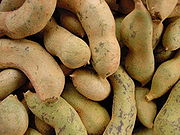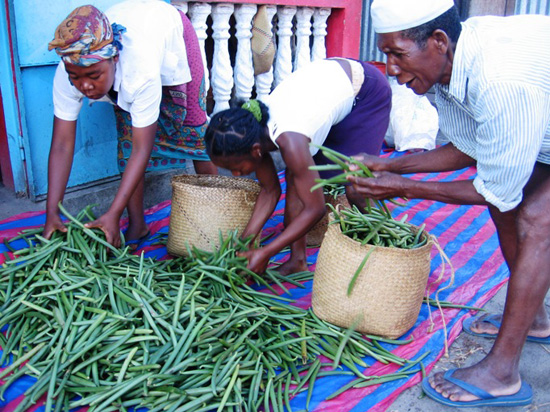I'm amazed at how superior your vanilla is!
– Des, The Grommet

Tamarind, Tamarindus indica, is native to tropical Africa, and grows wild throughout the Sudan. It was introduced into India so long ago that it is often considered indigenous there. It is extensively cultivated in tropical areas worldwide. Tamarind was introduced to the Americas sometime during the sixteenth century, and is now widely grown in Mexico and Central America.
The tamarind is well adapted to semiarid tropical conditions, although it also grows in humid tropical areas with seasonally high rainfall. Young trees are very susceptible to frost, but mature trees will withstand brief periods of temperatures as low as 28° F. Dry weather is important during the period of fruit development.
The 3 – 8 inch long, brown, irregularly curved pods grow along the new branches. As the pods mature, they fill out somewhat and the juicy, acidulous pulp turns brown or reddish-brown. When fully ripe, the shells are brittle and easily broken. The pulp dehydrates to a sticky paste enclosed by a few coarse stands of fiber. The pods may contain from 1 to 12 large, flat, glossy brown, ovoid seeds embedded in the brown, edible pulp. There are wide differences in fruit size and flavor. Indian varieties have longer pods with 6 – 12 seeds, while the West Indian varieties have shorter pods containing only 3 – 6 seeds.
The pulp of the tamarind pod has a pleasing sweet/sour flavor and is high in both acid and sugar. It is also rich in vitamin B and high in calcium. The pulp is used to make beverages, jams, jellies, jellied candy, and desserts, and is also used in savory dishes.
Ethno-medicinally, the leaves and bark have been used to reduce malarial fevers, and in ayurvedic medicine for digestive problems and for heart conditions. In Malaysia it is used as a wet compress to lower the body temperature and is supposed to help sore throats.
I was given a small bottle of Rain’s Choice in a gift basket and I have been hooked ever since. The flavor makes all of my baking so much better! I will never use grocery store vanilla again!


© 2021. All Rights Reserved
Designed/Developed by Kat & Mouse